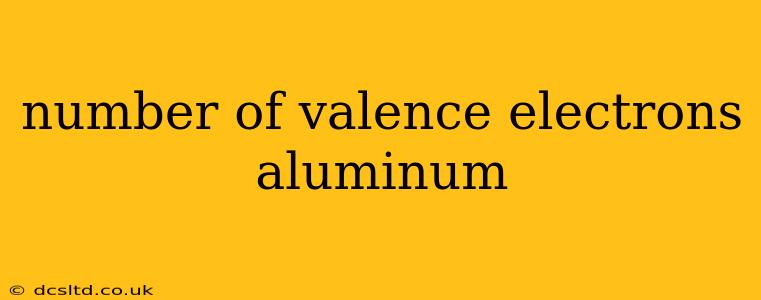Aluminum, a lightweight yet strong metal ubiquitous in everyday life, boasts a fascinating electronic structure. Understanding its valence electrons is key to grasping its chemical behavior and reactivity. This post will explore the number of valence electrons in aluminum, explaining the concept clearly and answering frequently asked questions.
What are Valence Electrons?
Before diving into aluminum's specifics, let's define valence electrons. These are the electrons located in the outermost shell (also known as the valence shell) of an atom. They're the electrons most involved in chemical bonding and reactions. The number of valence electrons determines an element's reactivity and the types of bonds it can form.
Determining Aluminum's Valence Electrons
Aluminum (Al) has an atomic number of 13, meaning it has 13 protons and 13 electrons in a neutral atom. To find the number of valence electrons, we need to examine its electron configuration: 1s²2s²2p⁶3s²3p¹.
The electron configuration shows us how electrons are distributed among the different energy levels and sublevels within the atom. The outermost shell is the third shell (n=3), containing the 3s and 3p electrons. Adding the electrons in the 3s and 3p orbitals (2 + 1 = 3), we find that aluminum has 3 valence electrons.
Why are Aluminum's 3 Valence Electrons Important?
The presence of three valence electrons explains aluminum's chemical properties. It readily loses these three electrons to achieve a stable octet configuration (like that of noble gases), forming a 3+ cation (Al³⁺). This tendency to lose electrons makes aluminum a highly reactive metal, readily participating in various chemical reactions.
What is the electron configuration of aluminum?
Aluminum's electron configuration is 1s²2s²2p⁶3s²3p¹. This configuration shows the distribution of its 13 electrons across different energy levels and sublevels. The superscripts indicate the number of electrons in each orbital.
How many electrons are in each shell of aluminum?
- First shell (n=1): 2 electrons (1s²)
- Second shell (n=2): 8 electrons (2s²2p⁶)
- Third shell (n=3): 3 electrons (3s²3p¹)
The third shell is the valence shell, containing the three valence electrons.
What is the oxidation state of aluminum?
The most common oxidation state of aluminum is +3. This is because aluminum readily loses its three valence electrons to achieve a stable electron configuration.
What are some common compounds formed by aluminum?
Due to its three valence electrons, aluminum forms a variety of compounds. Some common examples include:
- Aluminum oxide (Al₂O₃): A key component of bauxite ore and used in various applications.
- Aluminum hydroxide (Al(OH)₃): Used in antacids and water purification.
- Aluminum chloride (AlCl₃): Used as a catalyst in organic chemistry.
Aluminum's chemical reactivity and the versatility stemming from its three valence electrons make it a crucial element in numerous industrial processes and everyday materials. Understanding its electronic structure is fundamental to comprehending its unique properties and widespread applications.
